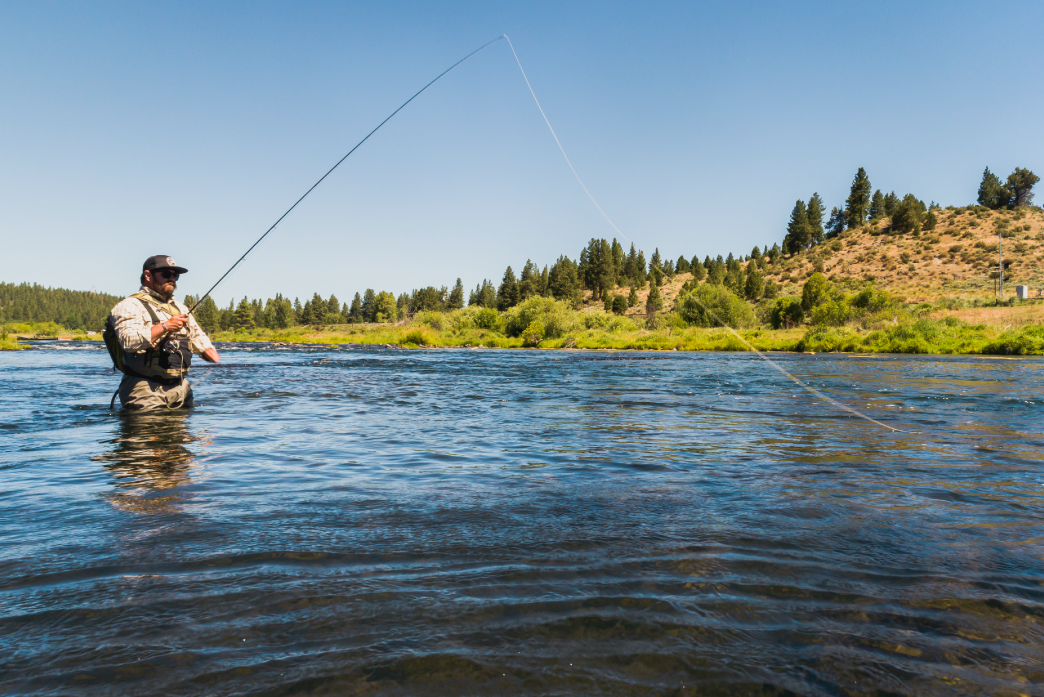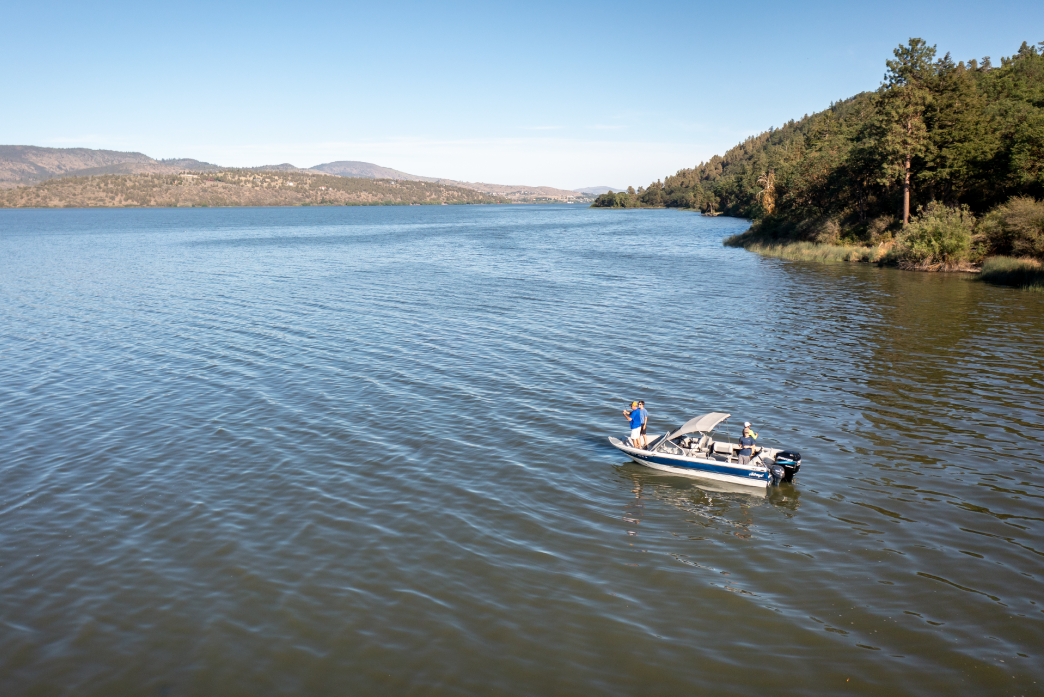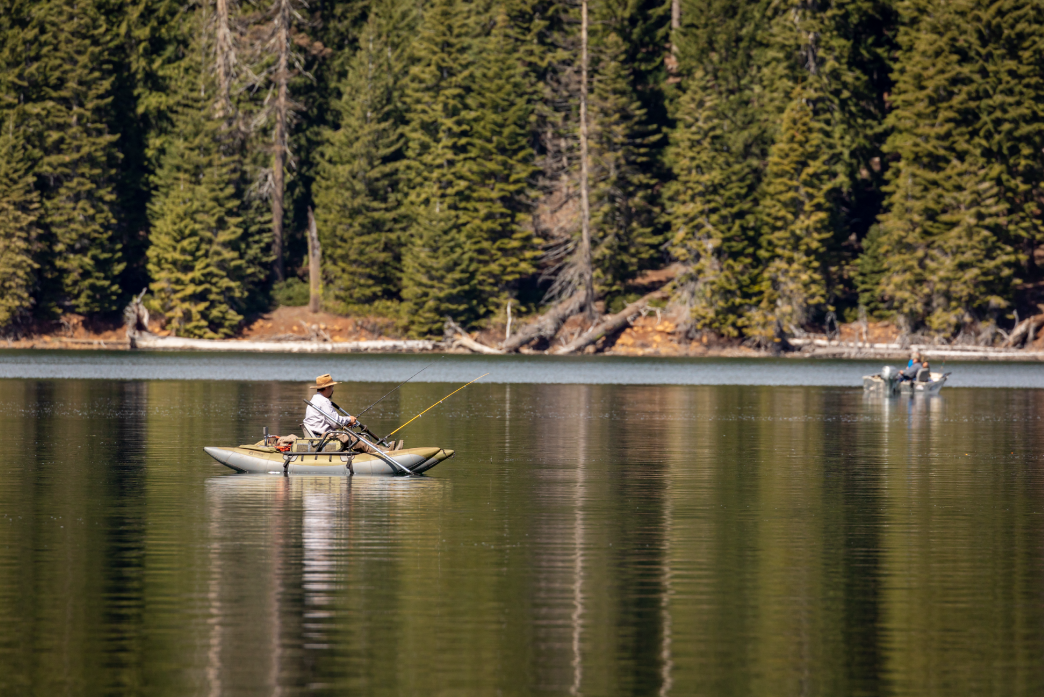Everything You Need to Know About Fishing in Klamath County
Klamath County is known for its wide range of landscapes, from pastoral farmland to old-growth forests. Take a closer look, though, and you’ll see that the area’s variety of waterways make it all possible: A few very important rivers run through Klamath County, alpine lakes dot the Cascade Range, freshwater streams crisscross the region’s wetlands and meadows, and Upper Klamath Lake has the distinction of being the largest freshwater body west of the Rocky Mountains.
With so many bodies of water, it’s no surprise that Klamath County offers incredible angling opportunities. All year long, anglers fish for several kinds of trout, kokanee (freshwater salmon), and other species—with different bodies of water proving fruitful during the various seasons.
It can be tough to know where to begin, so we’ve put together a guide to fishing the waters of Klamath County—where to go, what you’ll catch, and when the fish are biting at each lake, river, or stream. So once you’ve grabbed your essential fishing gear, here’s how to make the most of your time fishing in Klamath County.
Williamson River

Fishing in spring on the Williamson River in Klamath County, Oregon offers serene scenery, abundance of trout and adventure. Discover Klamath
Northeast of Klamath Falls sits the winding Williamson River, a spring-fed tributary of Upper Klamath Lake and one of the region’s most popular fly-fishing destinations. (Note that bait is not permitted in the Williamson River.)
The Williamson is best known for its runs of native redband trout, which run large and can be caught on a catch-and-release basis between late spring and early fall. Other highlights include smaller runs of brown trout (especially around Collier Memorial State Park) and brook trout near Klamath Marsh National Wildlife Refuge—one of several national wildlife refuges across the Klamath Basin.
Wood River
In the Fort Klamath area, almost directly north of Klamath Falls, the quiet Wood River lazily flows into Agency Lake and is best known for its large numbers of native redband trout that can grow to impressive sizes. (In fact, the Wood River Wetland sits near where the river flows into Agency Lake and offers a boat launch to get on the water.) Anglers can fly-fish for these massive trout between late April and the end of October—all on a catch-and-release basis.
The river’s leisurely current and cool waters also make it a popular place to catch brown trout and, in summer and fall, rainbow trout. The Wood River Day Use Area (open mid-June to mid-September) and bucolic Jackson F. Kimball State Recreation Site are fine places to launch a boat; rentals are available from Roe Outfitters (which also leads guided fly-fishing trips) and Sky Lakes Wilderness Adventures.
Klamath River
A Federally-designated “wild and scenic river”, the Klamath River cuts through steep canyons and offers some of the best high-volume trout fishing you may ever see. The Klamath River has a unique season and is open year-round save for June 15 – September 30, when it closes to limit stress-induced mortality. Catch and release is encouraged, though you can keep one fish over 15 inches per day if you want to carry it out on the miles-long hike out.
Access to the Klamath River is plentiful though anything but easy. This is not a place for those in poor shape or young children considering the rapid changes in elevation, steep, poorly-maintained roads and trails, sharp rocks, snakes, yellow jackets and potential for bears and cougars. That said, if you can make it down here, expect to catch more wild native trout in a day than almost anywhere else on earth! Fishing the Klamath River is as close to the kind of action that lures anglers to Alaska that you’ll find in the lower 48. If it’s your first time out on the Klamath River we recommend a guide.
Odell Lake
Odell Lake (one of the top lakes near Klamath Falls) sits in the heart of the Cascade Range and is among Klamath County’s most prolific and productive fisheries. Open to fishing between late April and the end of October, Odell Lake reaches 300 feet at its deepest point and has something for anglers of all ages, interests, and experience levels.
Odell Lake boasts the state record for the largest mackinaw (also known as lake trout) ever caught; the fish weighed an astonishing 40.5 pounds. Try your luck at besting the record between late April and early June; each spring, the Mackinaw Derby brings together anglers from all over for two days of tournament fishing.
The lake is also known for its prolific kokanee populations, native and hatchery-bred redband trout (frequently caught near the shore), bull trout (which must be released if caught by accident), and whitefish (which patrol Odell Lake’s shallow ponds). Boat rentals, overnight stays, and fishing gear are all available at Odell Lake Lodge & Resort.
Crescent Lake
Just south of Odell Lake, the laid-back Crescent Lake is another popular spot to catch kokanee, rainbow trout, brown trout, mackinaw, and the occasional whitefish. Most fishing at Crescent Lake takes place between mid-May and early fall; the rest of the year, the lake may be snowed in.
Hoodoo’s Crescent Lake Resort, open between late spring and early fall, rents kayaks and offers a boat launch. Campsites and cabins are available if you’d like to make a weekend out of it.
Upper Klamath Lake and Agency Lake

Fishing on Upper Klamath Lake provides anglers with a chance to catch trophy-sized trout and enjoy breathtaking views of surrounding mountains. Discover Klamath
Upper Klamath Lake and its northern arm (Agency Lake) make up the largest freshwater body west of the Rocky Mountains and are fed by a number of streams and rivers; naturally, the lakes offer plentiful fishing opportunities. Catch-and-release is encouraged but not required.
Between the two lakes, native redband trout is perhaps the most sought-after catch. These fish can sometimes reach 20 pounds and are most commonly caught in late fall and spring; during summer and early fall, they tend to congregate around Pelican Bay and Rocky Point near the lake’s western shore. (Just note that anglers can only catch one native trout per day in the lake.) Rocky Point also makes a fine place to catch yellow perch, with Rocky Point Resort offering boat rentals and fishing gear for sale in its general store. The Upper Klamath Canoe Trail is an excellent way to get on the water, spot local wildlife, and reel in the day’s catch.
For its part, Agency Lake also hosts bullhead catfish and perch populations (both commonly caught at the height of summer), as well as a small number of brown trout.
Lake of the Woods

Lake of the Woods offers world-class fishing, scenic views, and a variety of fish species to catch. Discover Klamath
The 1,150-acre Lake of the Woods sits in the heart of the Cascade Range—just 45 minutes northwest of Klamath Falls—and offers productive fishing for a variety of species all year long. (Yes, even in winter; learn more about visiting Lake of the Woods in the off-season.)
State officials routinely stock the cold lake with rainbow trout between April and June, making it easy to head home with a small haul. Brown trout also call the lake home, as do kokanee (which prefer its deeper waters), bullhead catfish, largemouth bass, yellow perch, and even crappie.
In winter, the lake is one of Oregon’s best places to try ice fishing; the Oregon Department of Fish & Wildlife sometimes hosts workshops that cover how to read the ice, what gear is necessary, and other helpful tips.
Lake of the Woods Resort is on-site and offers a concrete boat launch, fishing dock, plenty of access to the lakeshore, boat rentals, and a general store featuring fishing gear. Cabins and campsites encourage overnight stays.
Crater Lake National Park
Believe it or not, you can go fishing in Crater Lake! Better yet: You can keep whatever you catch from the lake’s emerald waters.
In the late 19th and early 20th century, Crater Lake was stocked with seven species of fish; today, just two—kokanee and rainbow trout—survive.
Within park boundaries, anglers can fish from the shoreline at Cleetwood Cove or take a boat tour to Wizard Island—where they can fish from the docks or at Fumarole Bay. Anglers don’t need a license within park boundaries but should be mindful of other rules and regulations around lures, wetsuits, and casting a rod around boat docks. Note that both destinations require hiking the Cleetwood Cove Trail, which loses about 700 feet in just 1.1 miles.


